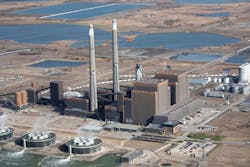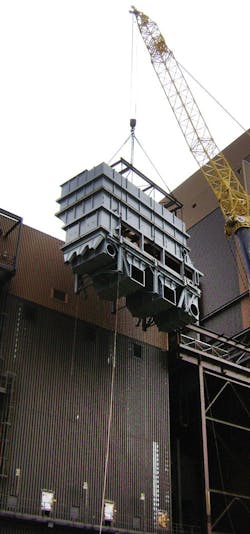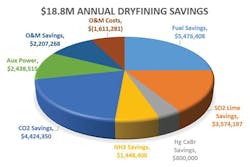Background
Between 1980 and 2000, the delivered fuel quality at Coal Creek Station, a North Dakota power plant, had degraded from 6,800 British thermal units (BTU) per pound (lb) (design specification) to 6,200 BTU/lb, and fuel moisture had increased from 29 percent by weight design to more than 38 percent, increasing the amount of fuel required and the volume of flue gas throughout the entire power plant. Station service increased to prep the additional fuel and move and treat all the extra flue gas. All eight of the plant’s pulverizers were required 24/7, with no spare capacity, and any time a pulverizer required maintenance, the unit was derated. Primary air crept up to 50 percent of total combustion air just to convey the higher moisture fuel to the burners, which restricted remaining air distribution for optimum combustion and nitrous oxide (NOx) tuning.
In addition, future emission regulations were tightening and more than $350 million in capital improvements would be needed to add equipment to meet the new emission targets over the next several years.
Coal Creek Station (pictured above) consists of two 600-megawatt (MW) pulverized coal units located in Underwood, North Dakota. The tangentially fired units by Combustion Engineering were commissioned in 1979 and 1981. The Falkirk mine-mouth plant is fired by North Dakota lignite.
Solution
Power cooperative Great River Energy‘s plant performance engineers started brainstorming possible solutions and came up with the idea of harnessing some of the waste heat around the power plant to “pre-dry” the coal back to original design specifications. They started with simple tests to see how easily the lignite could dry using low-temperature heat. Particular attention was paid to driving off water vapor without devolatilization (driving off other volatile organic compounds or approaching combustion). Fuel stability and moisture reabsorption was also tested. The pilot tests were successful and scaled up from bench scale to testing at the coal pile to a 2-ton-per-hour pilot unit in the yard. Management was supportive of the innovative concept at every stage.
In 2002, Great River Energy applied for Round 1 of the U.S. Department of Energy Clean Coal Power Initiative Program to help fund a 125-ton-per-hour demonstration dryer (1/8 scale) and was awarded $13.2 million to further develop the concept. A fluidized bed dryer was selected and adapted to intercept and dry coal flow to one pulverizer. This demonstration proved successful, and the decision was made to fully retrofit both 600-MW units with Great River Energy’s DryFining fuel enhancement process.
The equipment (see Image 2) was ordered and modifications were made during the next two years while the plant continued normal operations. The final tie-ins were made during regularly scheduled outages, so no lost time was incurred to retrofit the units.
Results
The fuel enhancement system has been operating at full commercial scale (1,000 tons per hour) since December 2009. By using waste heat from the plant to dry the lignite from 38 percent down to original design specifications of 29 percent, the higher heating value was increased from 6,200 to more than 7,000 BTU/lb (3,888 Kcal/Kg). In doing so, 10 percent less fuel is processed and 16 percent less flue gas volume – reducing fuel and station service costs. This results in a 4 percent increase in net unit heat rate.
A unique side effect of the fluidized bed coal dryer is the natural segregation of a dense fraction of the coal. This dense fraction contains a higher proportion of heavy material including pyritically bound sulfur and mercury, which is removed in the first stage, prior to combustion. And, since there is a lower volume of cleaner flue gas to treat, the existing pollution control equipment is more effective resulting in about 40 percent reduction in sulfur and mercury emissions.
The higher quality fuel also freed up primary air for better NOx tuning resulting in a 20 percent reduction in NOx. A 4 percent reduction in carbon dioxide was also achieved due to the improvement in net unit heat rate.
Best of all, these benefits reduced operating costs by more than $18 million per year (see Figure 1).
One of the major areas for savings is in the fuel budget. Now, less fuel is used to produce electricity. First, about 4 percent less raw fuel is purchased due to the overall system efficiency improvements. Secondly, less fuel is handled because of higher energy density, moisture and ash reductions downstream of the dryers throughout the balance of the plant.
Another area of significant savings is in air quality control system consumables (lime, calcium bromide and ammonia) due to the combination of a lower mass of cleaner refined coal. Combustion of drier coal eliminates a great deal of the moisture in the flue gas, which reduces the total volume of flue gas to be treated. Lower moisture also improves the performance of the wet flue gas desulfurization and mercury capture process. Reducing the primary air now required frees up combustion air for better staging in secondary over-fire air for improved NOx control.
Auxiliary power (station service) was reduced by 7.3 MW on a net basis even with the additional fans, pumps and conveyors (470 kW) used in the fuel enhancement process.
Another benefit is lower maintenance costs on the coal conduits and burner fronts due to higher quality fuel (less erosion) and reduced disposal costs for bottom ash because more ash is removed prior to combustion.
Reliability is second only to safety in a power plant and operators report they have successfully dried more than 50 million tons of lignite over the past eight years, representing more than 95 percent availability of the DryFining units.
Safety features
Safe handling and processing of coal is of utmost importance. The system is designed with core safety principles: 1) Using low-temperature waste heat to slowly dry the coal without driving off volatiles; 2) processing the coal at just the right time before combustion to minimize the opportunity for moisture reabsorption and spontaneous combustion; and 3) using operating procedures and safety equipment to actively monitor and control the dryer conditions to respond appropriately to undesirable conditions (carbon monoxide) before they become a problem.
What is next?
Great River Energy is working with dryer and boiler original equipment manufacturers to address retrofit and new construction markets (primarily overseas). New construction applications are particularly well suited for optimized drying and to take advantage of the physical and capital reductions that result from combustion of a higher quality fuel with a reduced volume of cleaner flue gas to treat.
Author’s note: DryFiningTM fuel enhancement process is a trademark of Great River Energy. Great River Energy has been awarded nine U.S. patents on the DryFining fuel enhancement process and the controls integration with a power plant.
Sandra Broekema, P.E., is director of Corporate and Business Development at Great River Energy. She may be reached at 763-445-5304. Great River Energy is a not-for-profit electric cooperative in Minnesota. It is the second largest electric power supplier in the state and one of the largest generation and transmission cooperatives in the country.




